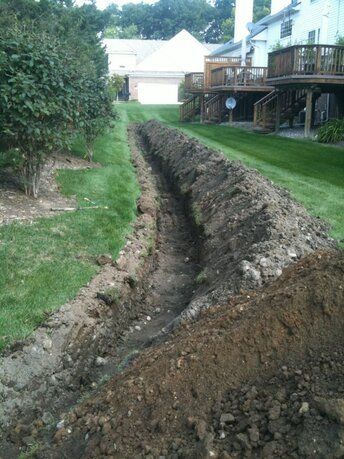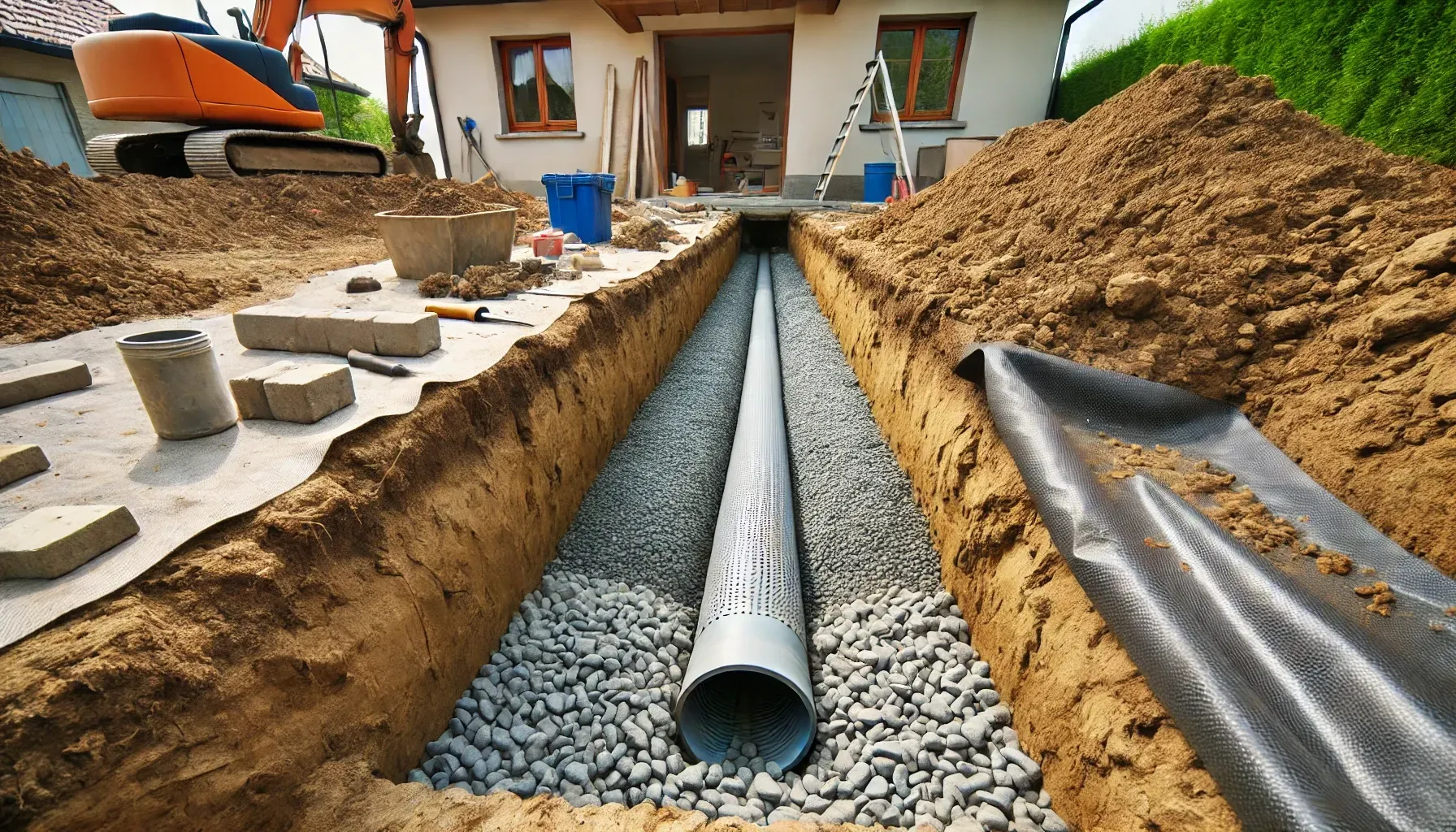French Drain Installation & Repair Washington, DC USA
French Drains are used to drain ground water from a garden, yard or farm to a lower region where it can be handled for other uses. A French drain or weeping tile, also known as a trough filled with stone or gravel or containing an underground perforated pipe is a trench lined with soil or rock with an outlet pipe. These drains are generally constructed with a type of closure device such as a French Drain stopper that keeps water inside the drainage system. The system can then be covered with a waterproof membrane to protect it from leaks.
Drainage systems in commercial and residential buildings are constructed differently than French drains. For instance, French drains are dug straight down from the outside into the
foundation. This prevents any sump pump action that can occur with a traditional excavating process. The excavation of the French drain allows for a more efficient use of existing soil for construction purposes, reduces the amount of excavating required and reduces the amount of water that seeps into the basement or cellar. If you're considering a French drain, there are several benefits to installing one:
A French drain allows for a direct water removal path to the main sewer line. Water can enter your home through an open or covered hole in the foundation. A trench lined with a French drain pipe makes it difficult for water to move into a basement or cellar. A perforated pipe on the outside of the pipe collects rainwater runoff from the exterior of the house and channels it away from your foundation. This channeling of water away from the foundation lessens the amount of water that can pool in your basement.
A French drain also provides better water circulation and hydrostatic control than do-it-yourself home excavating methods. It creates a watertight seal against soil erosion, which decreases water infiltration into the foundation. In addition, French drains can be made from materials that resist damage from evaporation like clay or rocks. These types of drains have a much smaller water consumption footprint than traditional pipe systems. In addition, the inlet grate directs water down into the sewer line and the drain, thus reducing the amount of water that leaks from your sewer system.
Installing a French drain is not as difficult as you might think. First, you must choose the proper diameter of French drain trench. Typically, French drains are available in three different pipe sizes - 24 inches, 48 inches, and 72 inches. Once you've selected the proper size of French drainage, you can then install the French drainage in your chosen place.
To create an effective French drainage, you must first prepare the area you will install the French drains. The trench drains are installed inside the ground, and you will need to remove some top soil to expose the bottom of the French drain. Once the soil is removed, you should excavate at least a foot into the ground and excavate in a direction that keeps the trench drains and soil together.
After the trench has been excavated, you should then build a frame that will hold the French drain installation. You can use steel tubing or wooden boards to make the frame. This frame will serve as a support for the French drain and will also keep the soil from draining away. The frame is then topped with a layer of soil and another layer of gravel.
Once the French drain pipe is securely placed, you can then dig a small hole for the drainage. Before digging a hole, however, you should make sure that you have a safe slope. Using a sloping surface that meets the depth of the trench will help ensure that the trench will have no water sitting on it and no way for water to flow away.
How We Do French Drain Installation?
At our company, we specialize in the installation and repair of French drains, ensuring that your property is protected from water damage. Our process is thorough, addressing the specific needs of various areas of your property from the basement to the landscape.
Installation Process
Initial Assessment: We start by assessing your lawn and property to understand the specific drainage needs. This involves checking for signs of erosion, standing water, and the overall landscape layout.
Designing the Drainage System: Our experts design a French drain system that efficiently manages groundwater and surface water. This includes deciding the strategic placement of storm drains and yard drainage pipes to prevent flood risks.
Digging and Laying the Drain: The installation process involves digging a trench or ditch where the French drain will lie. The trench is filled with gravel to facilitate proper water flow. We ensure that the gradient and pressure are optimized to prevent any future clogs or debris build-up.
Incorporating Additional Features: Depending on your specific needs, we may integrate a sump pump or additional basement waterproofing measures. This is particularly important for properties with a wet basement or those prone to heavy rains.
Repair and Maintenance
Regular Maintenance Checks: French drain maintenance is vital for long-term functionality. We inspect for any signs of sediment or root intrusion that might impede the drain's effectiveness.
Repair Services: Our repair French drain services include removing any clogs, repairing damaged sections of the drain, and ensuring the downspout and garden hose connections are functioning correctly.
Upgrades and Improvements: For areas with high mosquito or pest prevalence, we offer pest control solutions and can adjust the existing drainage system to alleviate these issues.
Why choose DC Foundation Repair & Waterproofing for French drain installation?
Choosing us for your French drain installation guarantees expert service from a dedicated French drain contractor.
We understand the nuances of DC drainage and DC drains systems, ensuring tailored solutions that address local topographical and soil conditions.
Our blog offers valuable insights into these complexities, helping you make informed decisions.
Contact us to access our services.
Frequently Asked Questions About French Drains
What is a French drain, and how does it work?
A French drain is a trench filled with gravel or rock containing a perforated pipe. The system is designed to collect and redirect water away from your home’s foundation or other problem areas, preventing water buildup that could cause flooding or foundation damage. The perforated pipe allows water to flow into the drain and is carried away to a designated drainage area.
Why should I install a French drain?
Installing a French drain is beneficial if you experience issues like:
- Water pooling around your home’s foundation
- Basement flooding
- Excessive moisture in your yard or crawl space
- Soggy landscaping
By redirecting water away from these areas, a French drain helps prevent structural damage and reduces the risk of mold growth and other water-related issues.
How long does a French drain last?
A properly installed French drain can last several decades, especially when high-quality materials like gravel, durable piping, and landscape fabric are used. Regular maintenance, such as checking for blockages or damage, can extend the lifespan of the system.
Where should a French drain be installed?
French drains are typically installed around the perimeter of a house foundation to prevent water from pooling against the structure. They can also be installed in low-lying areas of your yard or along retaining walls to manage excess water. A professional Washington DC contractor can assess your property and recommend the ideal location.
How much does it cost to install a French drain?
The cost of installing a French drain depends on the length of the trench, soil conditions, and the complexity of the installation. On average, the price ranges from $2,000 to $6,000 for a standard system. For larger or more complex systems, the cost may be higher.
Can a French drain prevent basement flooding?
Yes, French drains are highly effective at preventing basement flooding by directing water away from your home’s foundation. Paired with other basement waterproofing methods like sump pumps, a French drain provides comprehensive protection against water intrusion.
What are the key components of a French drain system?
French drain system consists of three main components:
- Trench: Dug around the foundation or problem area.
- Gravel: Surrounds the perforated pipe, filtering water as it moves into the pipe.
- Perforated Pipe: Collects and redirects water away from the area to prevent water buildup near the foundation.
What maintenance is required for a French drain?
French drains require minimal maintenance, but occasional inspections are important. Over time, debris or sediment may clog the system. To prevent blockages, clear out any debris from the surface gravel and ensure the perforated pipe remains free-flowing. Additionally, you may need to re-grade the area if soil settles.
Do I need a professional to install a French drain?
While it’s possible to install a French drain yourself, hiring professional DC contractors is recommended for optimal results. A professional will ensure the trench is properly sloped for drainage, use the best materials, and address any specific issues related to your soil and property layout.
How long does it take to install a French drain?
The installation process typically takes 1 to 3 days, depending on the size and complexity of the project. Larger systems or challenging soil conditions may extend the timeline. A professional contractor will provide a detailed estimate based on your property’s requirements.
Can a French drain solve yard drainage problems?
Yes, French drains are an excellent solution for managing excess water in yards. If your yard has low-lying areas where water tends to collect or become soggy after rain, installing a French drain can direct water away from the area, keeping your landscaping healthy.
Will a French drain affect my landscaping?
While the installation process involves some excavation, professionals will take care to minimize disruption to your landscaping. Once installed, the French drain is typically covered with gravel or soil, allowing grass or other plants to grow over the area.
Can a French drain help with crawl space water issues?
Yes, French drains are often installed to prevent water from entering crawl spaces. By directing water away from the foundation, you reduce the risk of moisture buildup in the crawl space, which helps prevent mold growth, wood rot, and other water-related damage.
What is the difference between an interior and exterior French drain?
Interior French drains are installed inside the basement along the perimeter of the foundation and are connected to a sump pump to remove water that enters the basement.
Exterior French drains are installed outside the foundation to prevent water from entering the home in the first place by redirecting it away from the structure.
Does a French drain require a permit?
In some areas, installing a French drain may require a permit, especially if it involves significant excavation or connects to a municipal drainage system. It’s best to consult with local Washington DC contractors who are familiar with the permitting process in your area.

“We thought we needed to install a completely new foundation, but they had some really great other options that were far more affordable and just as durable. We are so happy we called them for help.” – KJ Tomms
Jessica M.

“After seeing them repair our neighbor’s foundation, we decided to give them a call and they handled our work just as well as we expected and we highly recommend them to everyone.” – Sarah U.
Nicole L.

“They are the first and only call we make when we are seeking third party data that is impartial and accurate. They’ve helped us make sound decisions in our construction practices.” – Joey T.



